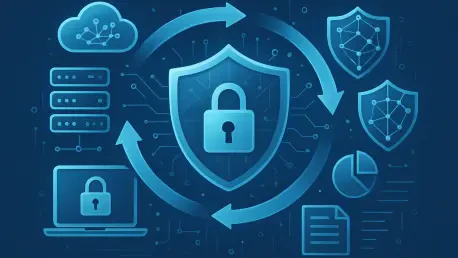In an era where digital threats are becoming more sophisticated and data breaches can cripple enterprises overnight, keeping abreast of the latest advancements in storage and data protection is not just beneficial but essential for any business aiming to safeguard its assets. The week of October 10 has brought a wave of significant developments in this critical field, showcasing how the industry is responding to mounting challenges with innovative solutions and strategic maneuvers. From cutting-edge technologies designed to thwart ransomware to pivotal leadership changes aimed at steering companies through turbulent times, these updates provide a glimpse into the future of data security. This comprehensive roundup delves into the most noteworthy announcements, offering insights for IT professionals, cybersecurity experts, and business leaders who are tasked with safeguarding sensitive information. As the digital landscape continues to evolve, staying informed about these breakthroughs is key to building resilient systems that can withstand the pressures of modern cyber threats.
Fortifying Defenses with Cyber Resilience
The urgency to bolster cyber resilience has taken center stage in the industry this week, driven by the relentless rise in ransomware and other malicious attacks. Companies are rolling out robust solutions aimed at protecting data and ensuring swift recovery when breaches occur. Object First has introduced ransomware-proof immutable storage tailored for edge environments, a move that addresses the vulnerability of decentralized systems. Meanwhile, Index Engines, in collaboration with Hitachi Vantara, has enhanced threat detection capabilities within enterprise backup frameworks, focusing on identifying and mitigating risks before they escalate. These advancements reflect a broader recognition that traditional security measures are insufficient against today’s sophisticated threats. By prioritizing immutable backups and rapid response mechanisms, vendors are helping businesses minimize downtime and maintain operational continuity even in the face of adversity.
Beyond specific product launches, the emphasis on cyber resilience signals a shift in mindset across the sector. Solutions are no longer just about prevention but also about recovery and adaptability in high-stakes scenarios. Arctera’s integration of identity protection with backup systems exemplifies this trend, ensuring that access controls are as robust as the data storage itself. This approach is particularly crucial for enterprises managing vast amounts of sensitive information across multiple platforms. As cyber attackers grow more cunning, employing tactics like social engineering alongside technical exploits, the need for comprehensive resilience strategies becomes undeniable. The industry’s response this week highlights a commitment to building layered defenses that protect not just data but also the trust and reliability businesses depend on. This focus ensures that organizations can bounce back quickly, preserving both their reputation and their bottom line.
Harnessing AI and Automation for Security
Artificial intelligence and automation are rapidly transforming the data protection landscape, offering powerful tools to stay ahead of emerging threats. BigID has launched an innovative access control feature specifically for AI conversations, addressing the often-overlooked risk of sensitive data leaks through conversational platforms. This development is a timely response to the growing use of AI in business operations, where unmonitored interactions can expose critical information. Similarly, IBM’s partnership with Anthropic to integrate secure large language models into enterprise solutions demonstrates a dedication to balancing AI’s potential with stringent governance. These efforts underscore the dual nature of AI as both a security enhancer and a potential vulnerability, prompting vendors to develop safeguards that keep pace with technological adoption.
Complementing these initiatives, Elastic’s latest Global Threat Report emphasizes the critical role of AI-driven analytics in countering complex cyber threats like phishing and ransomware. The report reveals how automation can process vast datasets to identify patterns and anomalies that human analysts might miss, thereby enabling faster and more accurate threat detection. This capability is becoming indispensable as attack vectors multiply and grow in sophistication. By leveraging machine learning algorithms, companies can predict potential breaches before they happen, shifting from a reactive to a proactive stance. The integration of such technologies into data protection frameworks is not just a trend but a necessity for enterprises aiming to secure their digital assets. As AI continues to evolve, its application in cybersecurity will likely deepen, offering even more robust tools to navigate the intricate threat landscape.
Advancing Storage for Next-Gen Workloads
Storage technology is undergoing a significant transformation to meet the escalating demands of AI, cloud computing, and other data-intensive workloads. Kioxia is set to unveil its next-generation flash storage at the upcoming OCP Global Summit, with a clear focus on optimizing performance and efficiency for AI applications. This move is a response to the exponential growth in data generation, where traditional storage systems often struggle to keep up with processing needs. By enhancing speed and scalability, such innovations aim to support businesses in harnessing AI’s full potential without compromising on infrastructure reliability. The spotlight on tailored storage solutions indicates a broader industry push to align hardware capabilities with the realities of modern digital environments.
In parallel, Scality’s collaboration with Inria is paving the way for intelligent storage systems designed specifically for cloud and AI-driven settings. This partnership focuses on creating adaptable solutions that can handle massive data volumes while maintaining accessibility and security. The emphasis on intelligence in storage reflects an understanding that raw capacity is no longer enough; systems must also anticipate usage patterns and optimize resources accordingly. Such advancements are crucial for enterprises transitioning to hybrid or fully cloud-based models, where data fluidity across platforms is paramount. As workloads continue to diversify, the development of storage technologies that can seamlessly integrate with emerging tech trends will be vital. This week’s updates highlight how vendors are stepping up to ensure that infrastructure evolves in tandem with business needs.
Steering Innovation Through Leadership Shifts
Strategic leadership changes are playing a pivotal role in shaping the future of storage and data protection, as companies position themselves for growth and innovation. Quantum’s recent appointment of Geoff Barrall as Chief Product Officer signals a strong intent to drive product development with a seasoned perspective, focusing on next-generation solutions for data security. Likewise, Exabeam’s naming of Pete Harteveld as CEO brings fresh energy to its cybersecurity initiatives, with an emphasis on scaling offerings to meet global demand. These executive transitions are more than just personnel updates; they reflect a deliberate strategy to align leadership expertise with the evolving challenges of the digital age, ensuring that companies remain agile and forward-thinking.
These shifts also underscore the importance of experienced guidance in navigating an increasingly competitive and threat-laden market. New leaders often bring renewed focus on innovation, customer needs, and operational efficiency, which are critical for maintaining a competitive edge. For instance, the expertise of incoming executives is expected to accelerate the rollout of cutting-edge tools that address specific pain points like ransomware recovery and data governance. As the industry grapples with complex challenges, the role of leadership in fostering a culture of adaptability and vision cannot be overstated. The moves announced this week suggest that companies are not only investing in technology but also in the human capital necessary to steer those technologies toward meaningful impact. This dual focus is essential for sustaining long-term progress in a field as dynamic as data protection.
Building Bridges Through Industry Collaboration
Community engagement and knowledge sharing are proving to be invaluable in addressing the multifaceted challenges of data security. Solutions Review’s upcoming event with Infinidat on October 28 offers a platform for professionals to explore the latest advancements in storage technology, fostering dialogue on best practices and emerging trends. Additionally, the Insight Jam Roundup for National Insider Threat Awareness Month brings together experts to discuss strategies for mitigating internal risks, a growing concern for many organizations. These initiatives highlight the industry’s commitment to collective learning, providing opportunities for IT leaders to exchange insights and refine their approaches to pressing security issues.
Such collaborative efforts are crucial in an environment where threats evolve rapidly, often outpacing individual organizations’ ability to respond. By creating spaces for discussion and shared expertise, these events help build a more resilient community capable of tackling challenges like insider threats and cyber vulnerabilities. They also serve as a reminder that data protection is not a solitary endeavor but a collective responsibility requiring input from diverse stakeholders. The focus on education and awareness ensures that businesses, regardless of size, have access to the knowledge needed to implement effective safeguards. As seen in this week’s announcements, the push for collaboration is a strategic move to strengthen the industry’s overall defenses, ensuring that solutions are informed by real-world experiences and expert consensus.
Charting the Path Forward with Proactive Measures
Reflecting on the flurry of activity during the week of October 10, it’s evident that the storage and data protection sector made significant strides in addressing urgent cyber threats. Companies fortified their offerings with resilience-focused solutions, harnessed AI to enhance security, and pushed storage technologies to new heights to support modern workloads. Leadership transitions and community engagements further complemented these efforts, setting a strong foundation for future growth. Moving forward, businesses should prioritize adopting these proactive strategies, integrating advanced recovery tools and intelligent systems into their operations. Exploring partnerships and tapping into industry events for insights will also be key to staying ahead of evolving risks. By embracing these actionable steps, enterprises can navigate the complex digital terrain with confidence, ensuring their data remains secure against whatever challenges lie ahead.









